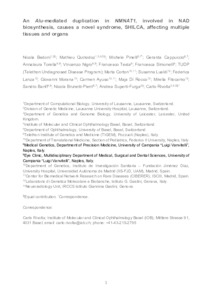Bedoni, Nicola and Quinodoz, Mathieu and Pinelli, Michele and Cappuccio, Gerarda and Torella, Annalaura and Nigro, Vincenzo and Testa, Francesco and Simonelli, Francesca and Telethon Undiagnosed Disease Programm, and Corton, Marta and Lualdi, Susanna and Lanza, Federica and Morana, Giovanni and Ayuso, Carmen and Di Rocco, Maja and Filocamo, Mirella and Banfi, Sandro and Brunetti-Pierri, Nicola and Superti-Furga, Andrea and Rivolta, Carlo.
(2020)
An Alu-mediated duplication in NMNAT1, involved in NAD biosynthesis, causes a novel syndrome, SHILCA, affecting multiple tissues and organs.
Human molecular genetics, 29 (13).
pp. 2250-2260.
![[img]](https://edoc.unibas.ch/style/images/fileicons/application_pdf.png)  Preview |
|
PDF
- Accepted Version
3968Kb |
Official URL: https://edoc.unibas.ch/79691/
Downloads: Statistics Overview
Abstract
We investigated the genetic origin of the phenotype displayed by three children from two unrelated Italian families, presenting with a previously unrecognized autosomal recessive disorder that included a severe form of spondylo-epiphyseal dysplasia, sensorineural hearing loss, intellectual disability and Leber congenital amaurosis (SHILCA), as well as some brain anomalies that were visible at the MRI. Autozygome-based analysis showed that these children shared a 4.76 Mb region of homozygosity on chromosome 1, with an identical haplotype. Nonetheless, whole-exome sequencing failed to identify any shared rare coding variants, in this region or elsewhere. We then determined the transcriptome of patients' fibroblasts by RNA sequencing, followed by additional whole-genome sequencing experiments. Gene expression analysis revealed a 4-fold downregulation of the gene NMNAT1, residing indeed in the shared autozygous interval. Short- and long-read whole-genome sequencing highlighted a duplication involving 2 out of the 5 exons of NMNAT1 main isoform (NM_022787.3), leading to the production of aberrant mRNAs. Pathogenic variants in NMNAT1 have been previously shown to cause non-syndromic Leber congenital amaurosis (LCA). However, no patient with null biallelic mutations has ever been described, and murine Nmnat1 knockouts show embryonic lethality, indicating that complete absence of NMNAT1 activity is probably not compatible with life. The rearrangement found in our cases, presumably causing a strong but not complete reduction of enzymatic activity, may therefore result in an intermediate syndromic phenotype with respect to LCA and lethality.
| Faculties and Departments: | 09 Associated Institutions > Institute of Molecular and Clinical Ophthalmology Basel (IOB)
09 Associated Institutions > Institute of Molecular and Clinical Ophthalmology Basel (IOB) > Research Group Rivolta IOB |
|---|
| UniBasel Contributors: | Rivolta, Carlo |
|---|
| Item Type: | Article, refereed |
|---|
| Article Subtype: | Research Article |
|---|
| Publisher: | Oxford University Press |
|---|
| ISSN: | 0964-6906 |
|---|
| e-ISSN: | 1460-2083 |
|---|
| Note: | Publication type according to Uni Basel Research Database: Journal article |
|---|
| Language: | English |
|---|
| Related URLs: | |
|---|
| Identification Number: | |
|---|
| edoc DOI: | |
|---|
| Last Modified: | 05 Sep 2023 03:10 |
|---|
| Deposited On: | 23 Dec 2020 11:14 |
|---|
Repository Staff Only: item control page


